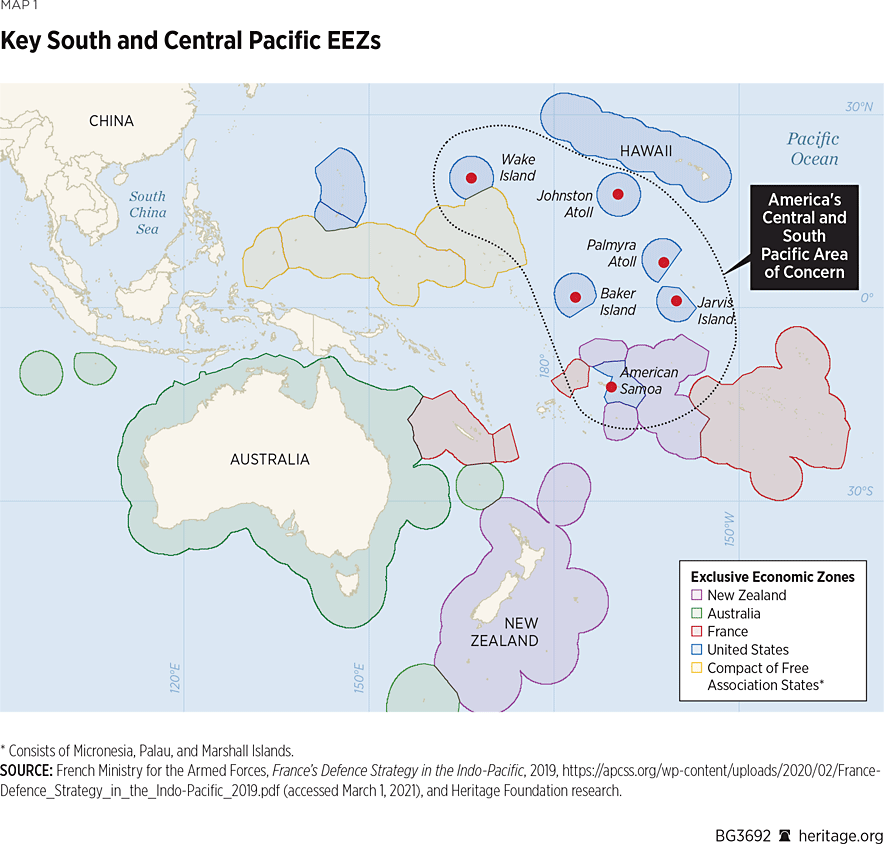The U.S. is engaged in a strategic competition with China across the political, economic, and military spectrum, and maritime security and resource protection is an important but often overlooked aspect of this competition. As recent events make evident, the potential incursion of a large Chinese fishing fleet protected by paramilitary units into U.S. waters is here. The challenge is such that any response must act in concert with Pacific allies to secure significant U.S. economic, military, and ecological interests. The threat is greatest in U.S. waters of the South and Central Pacific, where prompt action is most needed.
This response will require improved maritime policing, defense, and improvement of associated infrastructure, especially in the lightly patrolled South and Central Pacific. Improving the posture of the U.S. Coast Guard and dedicating platforms and resources to the existing security coordinating body—the Pacific Quadrilateral Security Dialogue (QUAD), consisting of Australia, France, New Zealand, and the U.S.—can achieve some early results economically, but is only a start to addressing the larger challenge.

The Challenge
In July 2020, over 300 Chinese fishing vessels gathered around—and sometimes in—the protected waters of Ecuador’s Galapagos Islands. At the time, the potential loss of endangered species in the Galapagos Marine Reserve and blighting of a UNESCO World Heritage site enraged many with a conservationist bent. Ecuadorian President Lenin Moreno saw also potential economic loss, and it was enough for him to seek multinational action.REF However, China’s global industrial fishing fleet is not just Ecuador’s problem, but a U.S. one as well.
In an arc stretching over 1,400 miles from Wake Island to Johnston Atoll and south 1,900 miles to American Samoa are six U.S. exclusive economic zones (EEZ), rich in fish and untapped natural resources. To protect the coral reefs and associated biodiversity, four Pacific marine national monuments were established by President George W. Bush in 2009.REF
In this arc are two marine national monuments, the Pacific Remote Islands (495,189 square miles), and Rose Atoll (13,436 square miles).REF Without improved U.S. maritime capacity and allied coordination these U.S. maritime rights are at risk. However, it is far from just about fish: Should a conflict erupt in Asia, the U.S. will rely on secure shipping and air freight across the region to support military operations.
The Rationale
China’s fishing fleets are globally significant both economically and ecologically. Since 2011, China’s appetite for seafood has driven imports—tripling to $15 billion in 2019 and pushing its fishing fleets further afield. Today they make up 38 percent of all global fishing activity.REF
Ecological. The ecological impacts are evident: Chinese “dark” fishing fleets have surged into the Sea of Japan to catch squid, which, since 2003, have faced significant population declines.REF Chinese distant fishing fleets are affecting American Samoa, Guam, and Hawaiian fisheries; the overall revenue loss to illegal fishing in the Pacific is estimated to be between $4.3 billion to $8.3 billion.REF
Regulatory. Complicating matters is that these distant-water fishing fleets are largely unregulated. Nominal responsibility for this resides with the Chinese Ministry of Agriculture and Rural Affairs, operating under the guidance of China’s Fisheries Law, now in its fifth version since its 1986 inception. However, these regulations lean more toward advocacy than restrictions. Their provisions include providing financial support, fuel subsidies, and tax exemptions.REF
Additionally, while China’s distant-water fishing fleet is largely off-the-books, it has been estimated to consist of up to 17,000 ships by using location data (e.g., AIS location data) and unique vessel identifier databases (e.g., Krakken’s FishSpektrum). Attempts to regulate this fleet are further hampered by opaque registration and ownership processes.REF
Strategic. Likewise, Chinese maritime forces have shown a predilection to protect—not regulate—Chinese fishing fleets. Chinese overseas enforcement is the responsibility of the Chinese Coast Guard (CCG), potentially supported by the paramilitary maritime militia that frequently operates in and amongst fishing fleets. This is worrisome, given the reporting by the China Maritime Studies Institute regarding these forces’ frequent use of intimidation in the South China Sea.REF
Drift-Net Fishing. There is, however, one bright spot. Since joining the North Pacific Coast Guard Forum in 2000, the CCG has coordinated enforcement of the United Nation’s ban on drift-net fishing in the North Pacific.REF Sadly, this bright spot may be dimming. Despite past good relations between U.S. and Chinese Coast Guards, alarms were raised in September 2021 when a Chinese naval four-ship flotilla was unexpectedly encountered in Alaskan waters. At the same time a separately deployed CCG flotilla was nearby, indicating China has the capacity to protect its fishing fleets as far afield as Alaska.REF
Then, in January 2022, the CCG escorted six Chinese Fisheries Company vessels that were threatened by pirates in the Gulf Aden.REF Such missions should be welcomed, but optimism regarding China being a responsible maritime stakeholder is likely misplaced, given the CCG’s track record of not restraining its fleets from poaching or harmful coral harvesting, especially in the South China Sea.REF It remains an open question whether drift-net ban enforcement by the CCG can be extended more broadly to counter wider concerns of illegal, unreported, and unregulated (IUU) fishing.
Without clear signs that the Chinese Communist Party will restrain its fishing fleets, there is growing potential for confrontation regarding fishing rights in the U.S. EEZ. Since the U.S. has the world’s most extensive maritime claims, it has a large area of vulnerable territory.REF It is likely Chinese fleets have attempted or will soon attempt to poach at scale in U.S. waters, and in that future scenario, U.S. fisheries valued at $5.6 billion could be put at risk.REF According to U.S. Coast Guard Commandant Admiral Karl Schultz, “IUU fishing has replaced piracy as the leading global maritime security threat.” The cost of global IUU fishing is estimated to be in the billions of dollars per year.
Following the Galapagos crisis amidst international awareness of IUU fishing, the U.S. Coast Guard released a strategic vision to combat IUU fishing. Actualizing that strategy, however, remains a work in progress.
U.S. Fisheries. U.S. fisheries are dispersed throughout its Pacific and Atlantic exclusive economic zones, but there are a few areas that stand out as especially important. The two primary ports for American fishing are New Bedford, Massachusetts, and Dutch Harbor, Alaska. New Bedford has the highest value in catch, and Dutch Harbor has the highest catch by volume. By value, the Atlantic catch is responsible for approximately 39 percent and, among the rest, Alaskan waters alone account for 32 percent. The rest of the Pacific (i.e., American Samoa, Guam, and Hawaii, etc.) accounts for 12 percent of U.S. seafood by value.REF Given that 20 percent of all catches are from IUU fishing—and that U.S. waters span a vast area consisting of remote U.S. territories—makes it difficult to patrol. All this means that America could lose up to $1 billion worth of lost catches in U.S. waters to IUU fishing.
The Coast Guard and the Navy
It is the Coast Guard’s and Navy’s responsibility to protect the nation’s maritime rights. But there are serious questions regarding the capacity of U.S. forces to address large-scale Chinese fishing fleets like those seen around the Galapagos Islands. The Navy supports the Coast Guard in its maritime security mission by periodically (on average, twice a year) assigning ships to the Oceania Maritime Security Initiative. This effort embarks Coast Guard personnel on Navy ships to improve maritime security and maritime domain awareness in the Pacific. However, due to operational demands on the Navy, these missions have been infrequent.
Coast Guard Response. The Coast Guard is the best tool for enforcing U.S. laws in its EEZs and has the responsibility for protecting marine and other resources, but consistent underinvestment has left it poorly positioned to address growing challenges. In recent years, the Coast Guard has sought to increase its assets based in the Pacific. Today, the Coast Guard’s District 14 patrols the South, Central, and Western Pacific with 10 cutters and maritime patrol aircraft.REF To increase this fleet, in July 2021, the Coast Guard commissioned three new Guam-based Fast Response Cutters.REF These smaller cutters are helpful, but alone are inadequate to cover the vast spaces of U.S. Pacific EEZs. Instead, these three new cutters will likely focus on the nearby EEZs of Guam and the Northern Marinas Islands.
Amidst increasing Chinese maritime presence, while still meeting national requirements, adequately patrolling U.S. waters in the Pacific requires a larger fleet. The Coast Guard plans to acquire 11 high-endurance National Security Cutters and 25 medium-endurance Offshore Patrol Cutters (OPC).REF Those cutters are planned to equip the Coast Guard for patrols covering all U.S. waters and conduct limited overseas deployments with the Navy.
Fleet Numbers. This planned fleet is likely inadequate given the scale of the maritime challenge from Chinese fishing fleets and its military. A 2011 Coast Guard study estimated that its planned acquisitions would only provide 61 percent of the cutters needed to fulfill the Coast Guard’s missions, and a later analysis found it could take up to 57 OPCs to meet mission demands.REF The study identified coverage gaps for various mission sets given the shortfalls of fleet capacity; assessed a high risk for the protection of marine life mission set; and warned of a very high risk for defense readiness, search and rescue, and counter-narcotic mission sets in various areas.
This assessment assumes the Coast Guard’s acquisition plan or “Program of Record” is completely funded.REF It also should be noted that China markedly stepped up its aggression and hostile acts in the years following 2011, which is not accounted for in the Coast Guard’s study. However, until the Coast Guard revises its 2004 Program of Record (its last official statement on the required fleet size), it remains uncertain how it will meet contemporary maritime challenges and with what resources.
Complicating the Coast Guard’s and the Navy’s efforts to improve presence in this region is the lack of any permanently based ships. The closest bases are in Guam and Hawaii, which include extensive EEZ patrol areas of their own. The problem is amplified as the existing infrastructure (ports, airfields) is antiquated, most dating to World War II or to the nation’s early space program, such as the airfield at Canton Island, Kiribati, which was shuttered in 1976. Needed are more naval forces in the region and their longer-term sustainment in the South and Central Pacific. These include ports, repairs facilities, and airfields. Thankfully, the U.S. is not alone in the region.
Regional Allies
Stronger collective action is a good first step to better safeguarding U.S. maritime rights in the South and Central Pacific. Allies Australia, France, and New Zealand are capable and resident partners in the Central and South Pacific. France has stationed significant forces (two surveillance Frigates, three patrol vessels, and five maritime patrol aircraft) and has territory (New Caledonia and French Polynesia) in the Pacific. Furthermore, France is a member of the Pacific QUAD (which includes Australia, New Zealand, and the U.S.) for coordinating security matters, and, as party to the 1992 FRANZ Agreement, coordinates regional humanitarian assistance with Australia and New Zealand.REF
Australia is an important regional partner. Central to its efforts is the Pacific Maritime Security Program, a $2 billion (Australian dollars), 30-year commitment of in-country staff sustaining a fleet of 21 patrol boats transferred to 12 Pacific island nations, providing regional aerial surveillance, and underwriting efforts to enhance regional coordination.REF However, the September 2021 grounding of Samoa’sREF single Australian-donated patrol boat exposed the limits of the program, leaving the island with no way of patrolling its waters and, therefore, reliant on partner nations.REF
Last, New Zealand has limited resources devoted to the region: 131 maritime patrol flying hours and 64 days at sea in fisheries patrols covering its 1.6 million square mile EEZ.REF Given their extensive and dispersed EEZs, individually these allies are hard-pressed to respond to large-scale poaching in their waters. However, better information-sharing and collective action can effectively focus limited naval resources to address the risk of large-scale IUU fishing and protect important sea-lanes.
Chinese and Taiwanese Tensions
But there is more at play than fish in the great-power competition with China for the Pacific. For decades, a diplomatic contest between Taiwan and China has played out over flipping diplomatic recognition between the two. Militarily, America’s decades-long dominance of the Pacific is fading. Notable are Russian long-range bomber deployments, like that to Indonesia in December 2017, as well as repeated distant Chinese naval deployments. Such deployments by our adversaries make clear the Pacific is being contested and can no longer be considered an American lake.
Today the South and Central Pacific includes critical sea and air lanes that support military operations in Asia, long assumed to be beyond any threat. This is no longer a viable military assumption, given Chinese and Russian long-range Pacific deployments, once again making the region of keen strategic importance.
Recommendations
Given the paucity of U.S. naval presence and the associated inadequate capacity to patrol its own EEZ, the following actions are offered for consideration.
Establish a Southern and Central Pacific Maritime Security Headquarters and Expand Support Infrastructure. To focus resources and enable better regional coordination, the U.S. Coast Guard Pacific Area Command and Indo–Pacific Command should establish a detachment in American Samoa. This headquarters’ mission would be to identify and execute needed maritime training and infrastructure projects supporting a sustained maritime security presence, while synchronizing operational (e.g., the U.S. Coast Guard’s Operation Blue PacificREF) and capacity-building activities with regional partners.
In time, this could include attached units like military construction battalions (e.g., Navy Seabees and Army Corps of Engineers) and home-porting Coast Guard cutters. Additionally, this headquarters would coordinate episodic naval deployments by allies like Japan and the United Kingdom to the region. This will become important, given that the United Kingdom has deployed two patrol ships to the Pacific until 2026. They are expected to periodically operate in this region.REF
Conduct Annual Pacific QUAD Naval Exercises in the South and Central Pacific. The focus should be to practice wartime logistics, maritime patrol, convoy operations, and interdiction of large fishing fleets (e.g., the 2020 Galapagos Islands incident). The first iteration of this exercise should be coordinated to occur in conjunction with the establishment of the headquarters in American Samoa overseeing these exercises. Additionally, given Japan’s growing and welcome diplomatic footprint in the region, there may be value in announcing the launch of this exercise from one of its regional embassies. This could also be beneficial in highlighting the economic and policing aspects of these exercises throughout the region. Allowance should be made for future participation of Pacific island nation navies, notably from Fiji and Tonga.
Standardize Maritime Policing Practices with Pacific Island Nations and Pacific QUAD Members. During the COVID-19 pandemic, there has been good use of virtual policing to enable a land-based third party to authorize maritime policing in its waters. This should be expanded and standardized so that, at a minimum, Pacific-QUAD members can support policing in all the participating nations’ EEZ.
Create a Regionally Focused Maritime-Security-Capacity-Building Funding Account. For South and Central Pacific Island Nations, Congress should establish a security cooperation account like the Maritime Security Initiative of 2015.REF Likewise, to enable greater regional economic maritime development with military utility, the U.S. Secretary of Defense should identify ports and airfields to the Development Finance CorporationREF for favorable solicitation of investment proposals.
The U.S. Coast Guard Should Increase Transparency on Its Fleet Needs by Updating Its Program of Record and Releasing a Report About the Degree of Risk It Is Accepting with Various Fleet Mixes. The lack of clear information on the Coast Guard’s fleet requirements makes it difficult for Congress to conduct effective oversight and for the public debate on new cutter acquisitions to be well-informed. Studies more than a decade old are still driving the debate—studies that do not take into account shifting mission demands and a dramatically changing global operating environment. In order to assist the Coast Guard to meet its missions, more information is required to inform the debate on the fleet.
Develop Techniques for Countering Large-Scale IUU Fishing. Given the size of Chinese distant-waters fishing fleets, the U.S. Coast Guard’s training and techniques need to be developed and practiced to protect U.S. waters. These techniques must include countermeasures for dealing with Chinese maritime militia interspersed amidst large fishing fleets.
Assess the Potential Value of Fishing and Implications of IUU Fishing in U.S. Waters. Congress should direct the U.S. Coast Guard, in concert with the National Oceanographic and Atmospheric Administration, to provide a report on the impact of illegal fishing on the U.S. fishing industry, impacts to local communities (e.g., American Samoa), and an update on the U.S. Coast Guard’s IUU Fishing Implementation Plan.
Conclusion
Because of other operational requirements, today’s U.S. Navy is largely absent from the South and Central Pacific. Fortunately, the Coast Guard has not had to deal with large illegal Chinese fishing fleets in U.S. waters—yet. Nevertheless, the day when it will is fast approaching, and today it has limited ability to interdict such illicit maritime activity in U.S. Pacific EEZs. To fund the U.S. Coast Guard for this mission will take a different mindset, one that Congress, the Biden Administration, and the military need to realize and implement.
Action is required to safeguard economic and security interests in this strategic region. Mobilizing the Pacific QUAD for maritime security is an important step until more Coast Guard cutters arrive. A visible and sustained maritime security presence in this region can deter IUU fishing while better securing critical sea and air lanes in the event of conflict in Asia.
Moreover, the Coast Guard will be an important player in the nation’s strategic approach to China. The Coast Guard is, in fact, the best trained to take on peacetime competition in this region while building coalitions of like-minded nations. For too long, multiple Administrations have underappreciated and under-resourced the Coast Guard for its unavoidable role in great-power competition with China. This must change.
Brent D. Sadler is Senior Fellow for Naval Warfare and Advanced Technology in the Center for National Defense, of the Kathryn and Shelby Cullom Davis Institute for National Security and Foreign Policy, at The Heritage Foundation. James Di Pane is Policy Analyst for Defense Policy in the Center for National Defense. Chad Wolf was Acting United States Secretary of Homeland Security in the Trump Administration.





